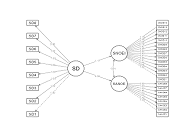To Identify the Consequence of Social Distancing on the Social Affinity Needs in the Lives of the Elderly

Abstract:
The present study aimed to examine the interrelatedness
of three key variables: The social affinity needs of the elderly, the social needs
of elderly individuals, and Social distance. To do this, a path analysis was conducted
on a sample of elderly individuals. In conclusion, this study provides evidence
of a complex relationship between social distance, social affinity needs and the
social needs of the elderly. Social space has a positive relationship with both
social affinity needs, and the social needs of the elderly, and social affinity
needs have a positive relationship with the social needs of the elderly. This study
provides valuable insights into the impact of social distancing on the social needs
and social affinity needs of the elderly population. It highlights the need for
interventions to support older adults during periods of social distancing. The previous two years were unpredictable. The epidemic has
had a remarkable effect on all population subgroups. In response to the global spreading
of the corona infection, the government devised social distance restrictions aimed
at high-risk age groups. The
indicated age group was those less than 65 years old. They are more susceptible
to such a sickness due to age-related symptoms, lower antibodies, physical and psychological
dependency upon one another, and especially lack of mobility. More than the danger of infection,
the stigma connected to this circumstance significantly impacts the elderly. This
generation faces increased mortality-related problems because of the comorbid condition.
References:
[1] D. Democracy,
the Market and the Forum. 2020. doi: 10.4324/9780203986820-27.
[2] D. Gujarati,
“Title,” pp. 5–7, 2010, [Online]. Available: “Not just old and sick - The ‘will
to health’ in later life,” Ageing Soc., vol. 29, no. 5, pp. 687–707, 2009,
doi: 10.1017/S0144686X08008271.
[3] K. U. Mayer,
“New directions in life course research,” Annu. Rev. Sociol., vol. 35, pp.
413–433, 2009, doi: 10.1146/annurev.soc.34.040507.134619.
[4] N. Lupu
and J. Pontusson, “The structure of inequality and the politics of redistribution,”
Am. Polit. Sci. Rev., vol. 105, no. 2, pp. 316–336, 2011, doi: 10.1017/S0003055411000128.
[5] F. Hong
Kong Istanbul Karachi “Recensions / Reviews Recensions / Reviews,” pp. 201–203,
1995, [Online]. Available: doi: 10.1016/0047-2727(92)90024-A.
[6] L. Lawton,
M. Silverstein, and V. Bengtson, “Affection, Social Contact, and Geographic Distance
between Adult Children and Their Parents,” J. Marriage Fam., vol. 56, no.
1, p. 57, 1994, doi: 10.2307/352701.
[7] T. Line,
J. Jain, and G. Lyons, “The role of ICTs in everyday mobile lives,” J. Transp.
Geogr., vol. 19, no. 6, pp. 1490–1499, 2011, doi: 10.1016/j.jtrangeo.2010.07.002.
[8] L. Srole,
“Social Integration and Certain Corollaries: An Exploratory Study,” Am. Sociol.
Rev., vol. 21, no. 6, p. 709, 1956, doi: 10.2307/2088422.
[9] T. Faist,
“Transnationalization in international migration: Implications for the study of
citizenship and culture,” Ethn. Racial Stud., vol. 23, no. 2, pp. 189–222,
2000, doi: 10.1080/014198700329024.
[10] C. Phillipson,
S. Yarker, L. Lang, P. Doran, M. Goff, and T. Buffel, “Covid-19, inequality and
older people: Developing community-centred interventions,” Int. J. Environ. Res.
Public Health, vol. 18, no. 15, 2021, doi: 10.3390/ijerph18158064.
[11] P. Higgs,
M. Leontowitsch, F. Stevenson, and I. R. Jones, “Not just old and sick - The ‘will
to health’ in later life,” Ageing Soc., vol. 29, no. 5, pp. 687–707, 2009,
doi: 10.1017/S0144686X08008271.
[12] M. Harangi-Rákos,
C. Pfau, É. B. Bába, B. A. Bács, and P. M. Kőmíves, “Lockdowns and Physical Activities:
Sports in the Time of Covid,” Int. J. Environ. Res. Public Health, vol. 19,
no. 4, 2022, doi: 10.3390/ijerph19042175.
[13] D. C. Giles,
“Parasocial interaction: A review of the literature and a model for future research,”
Media Psychol., vol. 4, no. 3, pp. 279–305, 2002, doi: 10.1207/S1532785XMEP0403_04.
[14] P. J. F.
Gantillon, “'The adventurer.”,” Notes Queries, vol. s9-I, no. 26, p. 507,
1898, doi: 10.1093/nq/s9-I.26.507-c.
[15] J. Baars,
“Aging: Learning to Live a Finite Life,” Gerontologist, vol. 57, no. 5, pp.
969–976, 2017, doi: 10.1093/geront/gnw089.
[16] W. Kymlicka,
W. Kymlicka, and W. Kymlicka, “Recensions / Reviews Recensions / Reviews,” pp. 201–203,
1995, [Online]. Available: doi: 10.1016/0047-2727(92)90024-A.
[17] W. Kymlicka,
W. Kymlicka, and W. Kymlicka, “Recensions / Reviews Recensions / Reviews,” pp. 201–203,
1995, [Online]. Available: doi: 10.1016/j.jtrangeo.2010.07.002.
[18] L. Kristov,
P. Lindert, and R. McClelland, “Pressure groups and redistribution,” J. Public
Econ., vol. 48, no. 2, pp. 135–163, 1992, doi: 10.1016/0047-2727(92)90024-A.
[19] J. DeFilippis
and S. Saegert, “Five Faces of Oppression: Iris Marion Young,” Community Dev.
Read., pp. 280–289, 2020, doi: 10.4324/9780203935569-42.
[20] Friedrich,
“Russian Pronominal Usage.pdf.” 1969. [Online]. Available: http://mapageweb.umontreal.ca/tuitekj/cours/2611pdf/Friedrich-Russian-Pronominal.pdf.

